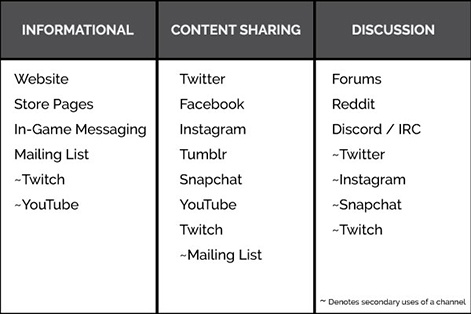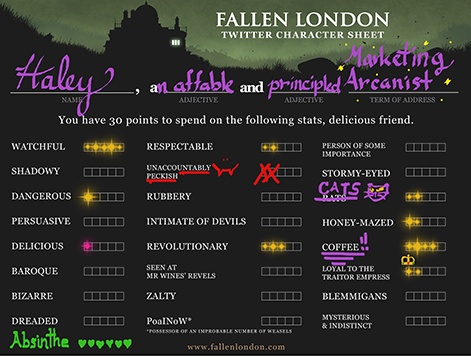In her third regular column for PCGamesInsider.biz, Failbetter marketing chief Haley Uyrus talks about how to build a community around your game ahead of launch
Now that the indie games space is more crowded, putting time and effort into building a community for your game is a must. Not only is it a way to boost your visibility ahead of your launch, but store pages these days favour titles with heavier wishlists stats.
Know Your Game
As with any marketing, a lot will vary depending on your game and what’s best for it. When you’re ready to start building your community, asking yourself a few questions will help you determine structural aspects of your community:
Would it be a good option for open development?
Will it be in Early Access?
How much runway does it have before launch?
Will it require a lot of players?
What are its USPs?
Do any of the platforms you’re releasing on have their own community spaces?
Know Your Audience
Keeping in mind what you know about your game, revisit what you know about your audience. You don’t want to set up a community space somewhere your audience won’t want to hang out. For example, if your audience trends older, setting up a Snapchat channel probably isn’t going to cut it. Or, if your game is more about the visual, it’d made sense to appear on Instagram over Reddit.
Where do they like to spend their time?
How do they find games?
What other games do they play?
What other interests do they have?
What type of things do they share?
Choose Your Locations
Use what you know about your game and your audience to start select some great spaces for your community. Especially if you’re an indie dev with a finite amount of time to focus on marketing, make sure the social media channels you’re picking count.

You don’t need to use all the channels out there, instead pick a healthy mix of informational, content sharing, and discussion mediums. By selecting a few from each column, you’ll ensure that information shared will cycle through an effective community loop that will work with individuals’ different commitment levels. Some people will only want to stop by for information, others will want to be aware of your milestones, and some will be heavily invested and want to interact with you regularly.
Note: If you don’t have a Kickstarter, your Mailing List and wishlists/pre-orders will become a lot more important, so make sure to spend time on getting people to sign up somewhere that you can notify them when your game is launched.
Create Your Space
Besides picking channels that make sense for the players you’re trying to attract, also make sure the space you create is:
Presentable! Spend some time at the beginning to make sure your pages look legit and professional. Make sure the important info listed is clear and easy to navigate.
Attractive! This is where your audience’s preferences come in. Fill your space with content that they will enjoy and that will help you attract new members.
Safe! One of the most important steps of starting a community is laying down the ground rules. Make them super clear and easy to find, so that current community members can direct new members
Share Your Content
Whether your sharing game news, studio antics or trying to strike up conversation, be sure your content is:
Consistent! Find what works for you and stick to it. There are plenty of tools to help you schedule regular content too if you’re also focusing on development work.
Authentic! The days of the personality-less corporations have passed. People distrust cold corporate marketing and prefer brands that take a stand on issues that are important to them.
Relevant! Create content worth sharing that matches the tone of your game. Join timely trends, holidays, or conversations.
Clear! Within the norms of the channel you’re using, use hashtags and other markers to help attract new community members.
Encouraging! Hold competitions or events that showcase your community’s skills. Share any fan art, cosplay or other creative acts to show your appreciation.
Fuel the Fire
Many of the suggestions above are about setting up a functional ecosystem for your community to thrive in. Not only will it make onboarding smoother for new members, but it should also help to retain users and encourage them to invite their friends to join.
Word of mouth is great (if not the best) type of advertising, but in order to speed up the process of growing your community, there are plenty of different ways to bring in new members.
Paid Ads
If you have some budget to put into an advertising spend, digital ads can be a cost-effective way to boost your reach and attract the attention of new members. If you’re not experienced at setting up digital ad campaigns, work with someone who is—as it’s the easiest way in the world to waste money. Even if you have a small budget, using your audience data to really fine-tune the targeting on your ads can make your campaigns extremely efficient.
Note: Most advertising is top of the sales funnel type of stuff, aka to spread awareness of your product. This is important to remember if you have a limited budget and are expecting digital ads to directly transfer into sales—if your aim is sales you’ll need a larger budget and plenty of time to tweak and adjust your campaigns. However, using it to spread awareness of your game will be helpful to growing your community.
Trailers and Special Content
Creating special content at important milestones will work double for you. Not only will your snazzy trailer excite your current community, but hopefully it’ll entice them to share it on their own feeds.
It doesn’t always have to be a trailer either, it could be as simple as a new piece of hero art. Or it could be something slightly off the beaten path, for example at Failbetter Games, we recently created a Fallen London character sheet for players to fill out and share on social media.

Press
Like advertising, gaining coverage widens the reach of your game and people’s awareness of it. Besides working with the press during big game milestones, try getting in touch with relevant publications to see if there are any features they’re currently working on that might fit well with your game or your studio.
Events and Speaking
Depending on your game, bringing it to consumer conventions is also a great way to add members to your community. Similar to the other categories above, it is difficult to make events directly correlate to game sales, but it’s the most real-life people to people way to get people involved in your community. Besides your game, consider creating event-specific competitions and special merch or other goodies that people can take away with them.
Test and Amend
Like any good marketing activity, building and growing a community will require a lot of iterations. As you go along, see which things work for your fans and fix what doesn’t. It’s a lot of hard work, particularly if this is the first game for your studio, but what effort you put into your community will really come back to you further down the line at your game launch, and hopefully for your next games too.
















